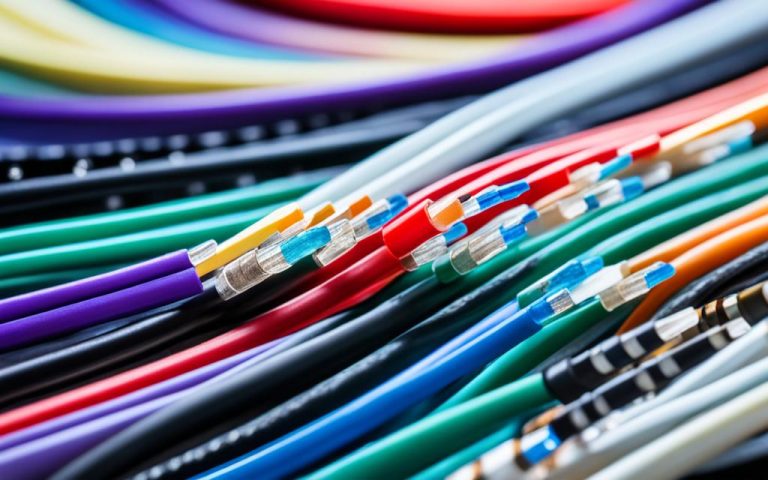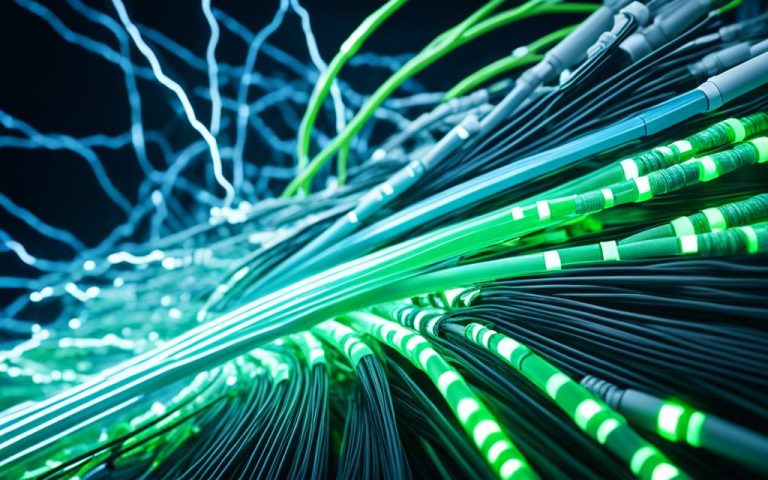Dense wavelength division multiplexing (DWDM) is a crucial technology in optical networks that is transforming the way data is transmitted over fiber-optic networks. By utilizing multiple light wavelengths to transmit signals, DWDM enables the simultaneous transmission of multiple channels over a single optical fiber.
With its ability to maximize the use of installed fiber cable and quickly provision new services, DWDM has revolutionized the capabilities of fiber optics. It has expanded channel capacity, enhanced efficiency over long distances, and transformed the landscape of optical communication.
The advancement of DWDM technology has greatly improved data transmission capabilities, making it an essential component in the digital age. Whether it’s in telecommunications, internet service providers, or large-scale data centers, DWDM technology plays a vital role in ensuring efficient and high-capacity data transmission for various applications.
How DWDM Technology Works
DWDM technology operates by transmitting signals over a single optical fiber using multiple light wavelengths. It utilizes a transmitter with an array of transmitters emitting distinct wavelengths simultaneously. These wavelengths are then consolidated or multiplexed using a Wavelength Multiplexer (MUX) and transmitted over the optical fiber. On the receiving end, a demultiplexer (DEMUX) separates the multiplexed signals into individual wavelengths, which are then directed to their respective receivers. This sophisticated method of optical fiber transmission allows for the concurrent transmission of multiple signals, leading to enhanced bandwidth and increased data transmission capabilities.
| DWDM | CWDM | |
|---|---|---|
| Channel Spacing | Close spacing (typically 50 GHz or 100 GHz) | Wide spacing (typically 20 nm) |
| Channel Capacity | High, supporting hundreds of wavelengths | Limited, supporting up to 18 channels |
| Application | Ideal for high-volume data transmission over long distances | Cost-effective solution for network bandwidth expansion |
| Advantages | High capacity and efficient utilization of optical cables | Cost-effective solution for shorter distances |
With the ability to transmit multiple signals simultaneously, DWDM offers a significant advantage over traditional optical fiber transmission methods. It provides enhanced bandwidth and enables the transmission of large amounts of data over long distances. The multiplexing and demultiplexing processes ensure efficient data transmission by utilizing multiple wavelengths within a single optical fiber. This technology has revolutionized the field of optical communication, making it a crucial component of modern fiber-optic networks.
Types of WDM Technology: DWDM vs CWDM
When it comes to Wavelength Division Multiplexing (WDM) technology, two prominent types stand out: Coarse Wavelength Division Multiplexing (CWDM) and Dense Wavelength Division Multiplexing (DWDM). While both are used in optical fiber networks for data transmission, they have distinct characteristics and applications.
CWDM:
CWDM is a cost-effective solution for expanding network bandwidth. It operates by using a wider spacing of 20nm between transmitted signals, which allows it to handle up to 18 channels over a single optical fiber. This makes CWDM ideal for applications where a moderate number of channels is required and cost-efficiency is a priority. However, it should be noted that CWDM has a relatively lower channel capacity compared to DWDM.
DWDM:
DWDM, on the other hand, stands out for its higher channel capacity and ability to accommodate a larger number of channels. It supports higher wavelength densities, reaching into the hundreds, allowing for the transmission of a significant amount of data. This makes DWDM the preferred choice for applications with high volumes of data traffic over long distances, such as data centers and long-haul telecommunications networks.
To better understand the differences between CWDM and DWDM, refer to the table below:
| Technology | Channel Capacity | Channel Spacing | Applications |
|---|---|---|---|
| CWDM | Up to 18 channels | 20nm | Cost-effective bandwidth expansion |
| DWDM | Higher channel capacity (hundreds of channels) | Narrow spacing | High-volume data transmission over long distances |
It is important to note that the choice between CWDM and DWDM depends on the specific requirements of the network and the desired level of channel capacity. While CWDM offers cost-effective bandwidth expansion, DWDM provides higher channel density and is preferred for applications with demanding data transmission needs.
The Advantages of DWDM Technology
DWDM technology brings several advantages to optical fiber communication systems. Firstly, it allows for the integration of a large number of channels within the same optical fiber, resulting in a substantial increase in channel capacity. This expanded channel capacity enables the efficient utilization of optical cables and enhances the overall efficiency of the network.
Additionally, DWDM technology compensates for amplification and dispersion challenges, ensuring reliable communication over extended distances. This makes it a preferred choice for applications requiring efficient and high-capacity data transmission across large geographic areas.
| Advantages of DWDM Technology | Benefits |
|---|---|
| Increased Channel Capacity | Enables the integration of a large number of channels within a single optical fiber. |
| Enhanced Efficiency | Optimizes the utilization of optical cables, leading to improved overall network efficiency. |
| Reliable Communication | Effectively compensates for amplification and dispersion challenges, ensuring reliable communication over extended distances. |
“DWDM technology revolutionizes optical fiber networks by maximizing channel capacity and improving efficiency, providing reliable high-capacity data transmission over long distances.”
Fiber Amplifiers and DWDM
To overcome dispersion and attenuation issues in DWDM systems, fiber amplifiers are utilized. Erbium-doped fiber amplifiers (EDFAs) are commonly used in DWDM systems as they amplify the incoming signal optically, boosting the wavelength. EDFAs are silica-based optical fibers doped with erbium, which can amplify light at 1550 nm. The amplification process in EDFAs is independent of the data rate, making them ideal for upgrading systems without changing the launch/receive terminals. These fiber amplifiers increase system efficiency and reduce the number of amplifiers required in a given design.
Fiber amplifiers play a crucial role in signal amplification and data transmission in DWDM systems. By amplifying the optical signals without converting them into electrical signals, fiber amplifiers maintain the integrity and efficiency of the transmitted data. EDFAs specifically offer advantages in terms of their bandwidth amplification range and compatibility with existing DWDM systems.
DWDM System Considerations
When implementing a Dense Wavelength Division Multiplexing (DWDM) system, there are several crucial components to consider. These components play a vital role in ensuring the efficient transmission and reception of optical signals, allowing for the seamless operation of the network.
Transmitters
The transmitters are responsible for generating the optical signals that will be transmitted over the DWDM system. They consist of a transmitter array that emits distinct wavelengths simultaneously. The transmitters must be carefully calibrated and aligned to ensure accurate and reliable signal transmission.
Receivers
The receivers in a DWDM system receive the transmitted optical signals and convert them back into electrical signals for further processing. They need to be sensitive to detect and differentiate between closely spaced wavelengths to ensure accurate reception. The quality and performance of the receivers directly impact the overall efficiency and reliability of the system.
Multiplexers and Demultiplexers
Multiplexers and demultiplexers, commonly referred to as MUX and DEMUX, respectively, are essential components of a DWDM system. They enable the simultaneous transmission of multiple optical signals over a single fiber and separate them upon reception. The MUX combines the individual wavelengths into a single signal, while the DEMUX separates the combined signal into its original wavelengths.
It is crucial for MUX and DEMUX components to comply with International Telecommunication Union (ITU) channel standards. They must be designed to handle closely spaced optical wavelengths, with passbands as narrow as 0.4 nm. Additionally, MUX and DEMUX must be stable over time and temperature, possess a relatively flat passband, and effectively reject adjacent channels to prevent interference.
“The seamless operation and efficiency of a DWDM system heavily rely on the proper alignment and calibration of transmitters, receivers, multiplexers, and demultiplexers.”
Fiber Amplifiers
In addition to transmitters, receivers, and multiplexers/demultiplexers, fiber amplifiers are crucial components of a DWDM system. Fiber amplifiers, such as Erbium-doped fiber amplifiers (EDFAs), play a crucial role in boosting the optical signals to compensate for transmission losses and ensure reliable long-distance communication.
EDFAs are silica-based optical fibers doped with erbium, which can amplify light at a wavelength of 1550 nm. These amplifiers are independent of the data rate, making them ideal for upgrading systems without changing other system components. By amplifying the signals optically, EDFAs enhance system efficiency and reduce the number of amplifiers required in a given design.
Below is a table summarizing the important components of a DWDM system:
| Component | Description |
|---|---|
| Transmitters | Generate optical signals for transmission |
| Receivers | Convert received optical signals into electrical signals |
| Multiplexers | Combine multiple wavelengths into a single signal |
| Demultiplexers | Separate combined signals into individual wavelengths |
| Fiber Amplifiers | Boost and amplify optical signals for long-distance transmission |
By carefully considering and implementing these components, a DWDM system can effectively interface with other equipment, implement optical solutions throughout the network, and ensure efficient data transmission over optical fibers.

Channel Spacing and Signal Direction in DWDM
Channel spacing plays a crucial role in the performance of Dense Wavelength Division Multiplexing (DWDM) systems. The International Telecommunication Union (ITU) has established standard channel spacing options, with 100 GHz being the most commonly used. The channel spacing determines the minimum frequency separation between two multiplexed signals, ensuring efficient transmission.
The choice of channel spacing depends on various factors, including the optical amplifiers and the capabilities of the receivers to identify and separate closely spaced wavelengths. Optimal channel spacing enables the DWDM system to effectively transmit and receive signals, maximizing the potential of the optical fiber network.
The DWDM band is divided into the red band and the blue band, each offering different advantages and cost considerations. The red band typically operates between 1525 nm and 1565 nm, while the blue band operates between 1585 nm and 1610 nm. The choice between the red and blue bands depends on the specific requirements of the network and the available components.
Overall, channel spacing, in accordance with ITU standards, ensures the efficient and reliable transmission of multiple signals in DWDM systems. By considering channel spacing and signal direction, network operators can optimize performance, improve data transmission, and enhance the capabilities of their fiber-optic networks.
Conclusion
DWDM technology represents a significant advancement in the world of fiber optics, bringing forth a host of benefits for data transmission. By leveraging the power of DWDM, fiber-optic networks can achieve remarkable enhancements in channel capacity, data transmission efficiency, and long-distance connectivity.
With the ability to transmit multiple signals simultaneously over a single optical fiber, DWDM technology meets the ever-growing demand for efficient and high-capacity data transmission in today’s interconnected world. This technology optimizes the use of existing fiber cables, ensuring the most efficient utilization of resources.
In conclusion, DWDM plays a pivotal role in expanding the capabilities of optical fiber networks and revolutionizing modern communication. It sets the stage for enhanced data transmission and empowers various applications that rely on robust and high-speed connectivity. As the world continues to thrive on seamless connectivity, DWDM technology will continue to shape and enhance the future of optical fiber networks.
FAQ
What is DWDM technology?
DWDM technology, also known as Dense Wavelength Division Multiplexing, is a crucial technology used in optical networks to efficiently transmit signals over a single optical fiber. It maximizes the use of installed fiber cable and enables the simultaneous transmission of multiple channels.
How does DWDM technology work?
DWDM technology operates by using multiple light wavelengths to transmit signals over a single optical fiber. A transmitter with an array of transmitters emits distinct wavelengths, which are then consolidated or multiplexed using a Wavelength Multiplexer (MUX) and transmitted over the optical fiber. On the receiving end, a demultiplexer (DEMUX) separates the multiplexed signals into individual wavelengths.
What is the difference between DWDM and CWDM?
DWDM (Dense Wavelength Division Multiplexing) and CWDM (Coarse Wavelength Division Multiplexing) are both types of WDM (Wavelength Division Multiplexing) technology. The main difference lies in their channel capacities and applications. CWDM supports a wider spacing of 20nm between transmitted signals and can handle up to 18 channels, while DWDM supports higher wavelengths densities and accommodates larger numbers of channels, making it ideal for applications with high volumes of data traffic over long distances.
What are the advantages of DWDM technology?
DWDM technology brings several advantages to optical fiber communication systems. It allows for the integration of a large number of channels within the same optical fiber, resulting in a substantial increase in channel capacity. Additionally, DWDM technology compensates for amplification and dispersion challenges, ensuring reliable communication over extended distances, making it a preferred choice for applications requiring efficient and high-capacity data transmission across large geographic areas.
What are fiber amplifiers and their role in DWDM?
Fiber amplifiers, specifically Erbium-doped fiber amplifiers (EDFAs), are used in DWDM systems to compensate for dispersion and attenuation issues. EDFAs amplify the incoming signal optically, boosting the wavelength. These amplifiers are silica-based optical fibers doped with erbium and can amplify light at 1550nm. EDFAs increase system efficiency and reduce the number of amplifiers required in a given design, making them ideal for upgrading systems without changing the launch/receive terminals.
What are the important components of a DWDM system?
Important components of a DWDM system include transmitters, receivers, fiber amplifiers, DWDM multiplexers, and demultiplexers. These components, in compliance with ITU channel standards, enable the DWDM system to interface with other equipment and implement optical solutions throughout the network. DWDM multiplexers and demultiplexers are designed to handle closely spaced optical wavelengths, with passbands as narrow as 0.4 nm.
What is the significance of channel spacing in DWDM systems?
Channel spacing is an important consideration in DWDM systems as it determines the minimum frequency separation between two multiplexed signals. The ITU defines standard channel spacing options of 50 GHz and 100 GHz, with 100 GHz being the most commonly used. The choice of channel spacing depends on the system’s components, including the optical amplifiers and the receivers’ ability to identify and separate closely spaced wavelengths.
How does DWDM technology revolutionize fiber optics?
DWDM technology revolutionizes fiber optics by enabling high-capacity data transmission over a single optical fiber. It maximizes the use of installed fiber cable, enhances channel capacity, and improves efficiency over long distances. With its ability to transmit multiple signals simultaneously, DWDM supports the growing need for efficient and capable data transmission in a connected world, shaping modern communication and enhancing data transmission for various applications.




















One Comment